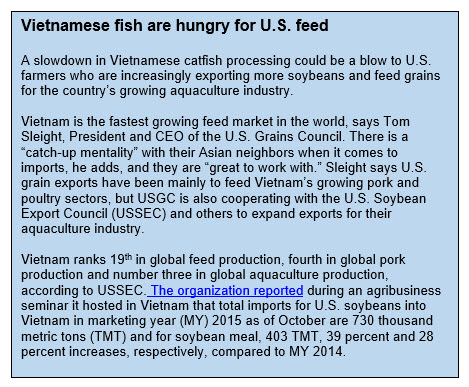WASHINGTON, Dec. 9, 2015 - Catfish exporting countries including Vietnam will be getting some high-level help from USDA early next year as the nations prepare to apply to keep their ability to ship catfish to the U.S. after the department’s Food Safety and Inspection Service (FSIS) takes over inspections.
USDA Deputy Under Secretary for Food Safety Al Almanza and Deputy Under Secretary for Farm and Foreign Agriculture Services Alexis Taylor are scheduled to begin their trip to Vietnam, Thailand and China in late January, according to USDA officials. They will be working with officials in Hanoi, Bangkok and Beijing as the foreign governments try to make sure their food safety regulations are up to FSIS standards.
The USDA released its long-awaited and controversial final rule to take over domestic and imported catfish inspection from the Food and Drug Administration on Nov. 25, giving foreign producers up to 18 months to apply for “equivalency” status and the ability to keep exporting to the U.S. Vietnam, the largest catfish supplier to the U.S., fought the change for years, worried that new, stricter regulation under FSIS would restrict its exports.
The first step that countries like Vietnam will have to take is providing FSIS with a list of all their exporters by March 1, 2016. After that, they will have 18 months – until Sept. 1, 2017 – to present documentation that shows their “inspection systems are equivalent to that of the United States,” according to the final rule. And as soon as the documentation is turned over, FSIS will begin its confirmation audits.
“If FSIS found that a foreign establishment is not in compliance with United States requirements for imported products, FSIS would terminate the eligibility of the establishment,” the rule says.
If Vietnam’s producers were to fail, the impact would be substantial. About 73 percent of catfish consumed in the United States currently comes from Vietnam, according to the Catfish Farmers of America. And it would be a very public disgrace for Vietnam, which has 70 processing and exporting operations that ship about $2 billion worth of the fish to 145 countries, according to the Vietnam Association of Seafood Exporters and Producers.
Cheaper imports from countries like Vietnam have rapidly displaced U.S. production over the past two decades, pushing many U.S. catfish farmers out of business. Vietnam sent about 213 million pounds of pangasius, a type of catfish in the siluriformes family, to the U.S. in 2012, up from 36 million pounds just five years earlier, according to government data.
The threat of losing its export market prompted Vietnam to threaten a disruption in the Trans-Pacific Partnership talks, but U.S. Trade Representative Michael Froman succeeded in placating the country with a promise that the U.S. would help Vietnam achieve equivalency.
The Almanza and Taylor trip to Vietnam and other exporting
nations next month is a direct result of that promise, USDA officials said.
But even with the new federal rule now in place seven years after Congress ordered USDA to take over catfish inspection in the 2008 farm bill, there is still an effort on Capitol Hill to scuttle the whole thing from lawmakers who see it as a waste of taxpayers’ dollars.
Sens. John McCain, R-Ariz., and Kelly Ayotte, R-N.H., on Monday introduced a bill to kill the USDA catfish inspection program.
“We are proud to continue the fight to repeal the USDA catfish inspection office, which is an egregious waste of taxpayer dollars and a classic example of anti-free market protectionism,” the senators said in a joint statement. “The Obama administration’s establishment of this program comes despite the fact that the Food and Drug Administration already performs seafood inspections and the Governmental Accountability Office has repeatedly warned that the USDA catfish office would be ‘wasteful and duplicative’ and would invite retaliation from Asian-Pacific trading partners against American agriculture exports.
#30
For more news, go to: www.Agri-Pulse.com

